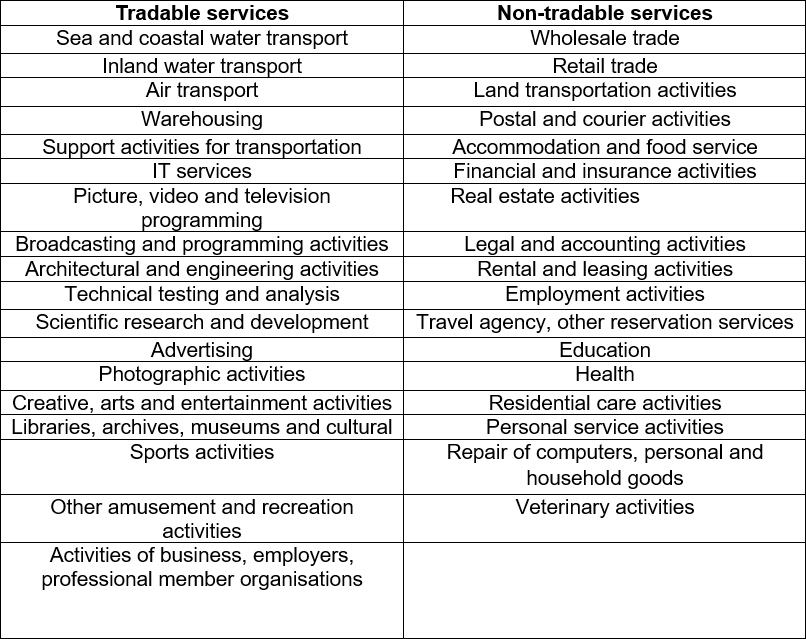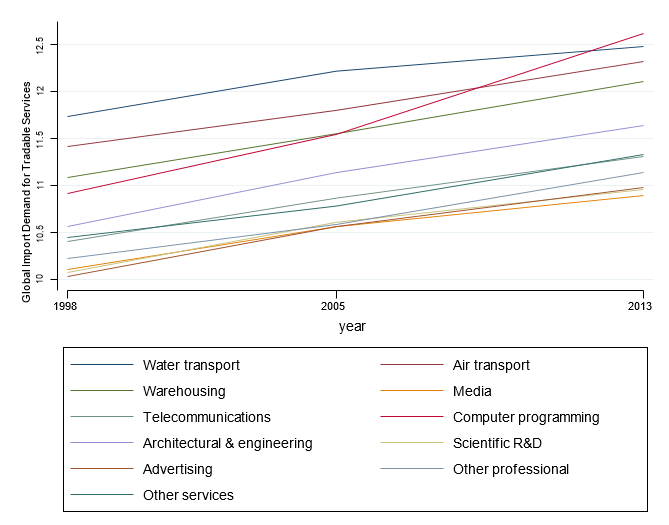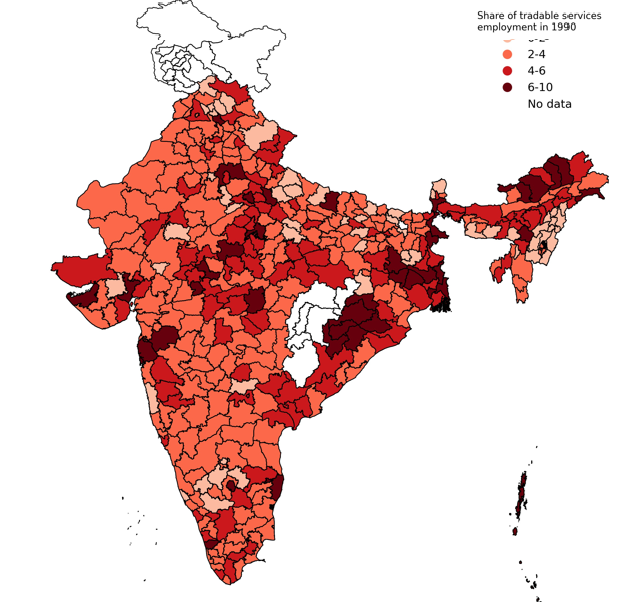A share of India's service sector growth can be attributed to tradable services, which can also have positive productivity impacts on manufacturing. This article looks at the effect of services trade on employment growth in non-tradable services. It finds that an increase in tradable services employment led to an increase in employment in non-tradable services from 1990 to 2013, and that this is explained by increases in consumer demand. The impact is larger among female workers and small firms.
Since the 1980s, the shares of manufacturing in value-added and employment across a range of developing economies peaked at lower levels of per capita income than in, early industrialised economies (Rodrik 2016). This ‘premature’ deindustrialisation reflects a structural transformation, where the services sector has grown relatively faster. Some of this growth can be attributed to tradable services (such as information and communications technology, business, and financial services) that are offshorable just like goods. Digital technologies have boosted trade in these services (Freund and Weinhold 2002), many of which now have trade costs comparable to manufacturing industries (Gervais and Jensen 2019). Tradable services have also had broader productivity impacts because they enable trade in goods. For instance, there is evidence that the liberalisation of telecommunications and transportation services has improved the productivity of downstream manufacturing firms (Bas 2014, Arnold et al. 2016).
However, many of these tradable services are also typically skill-intensive (Nayyar 2012a, Amirapu and Subramanian 2015, Nayyar et al. 2021a). Large numbers of low-skilled workers are often employed in services such as retail and hospitality, that are associated with a high intensity of face-to-face interaction between consumers and services providers. While there is some evidence to suggest that these non-tradable services have contributed to productivity growth (Fan et al. 2021), demand is typically constrained by the size of the local market. This reduces workers’ opportunities to benefit from international trade. Therefore, a first order question is whether less traded services that often account for the lion’s share of services employment1 in developing economies can benefit from services trade. India provides relevant context, given the rapid growth of its export-oriented services (such as software and business process outsourcing) since the 1990s (Eichengreen and Gupta 2011; Nayyar 2012a).
Data and methodology
In a recent study (Avdiu et al. 2022), we study this question by assessing the effects of employment growth in tradable services on employment growth in non-tradable services, across Indian districts between 1990 and 2013.
To classify sectors into tradable and non-tradable, we follow the approach proposed by Head and Ries (2001), and then adapted by Chen and Novy (2011) using data from the World Input-Output Database.
Following these definitions, implied bilateral trade costs can be expressed as a ratio of intra-national to international trade flows. All else being equal, the more two countries trade with each other, the lower is the measure of relative trade costs. Conversely, if domestic consumption becomes relatively more important in either country, this indicates larger international trade frictions or lower tradability. We set the threshold for trade costs equal to the highest level for manufacturing, such that all manufacturing is just tradable. Our sample then contains 35 broad service sectors, of which 17 are classified as non-tradable (Table 1).
Table 1. List of tradable and non-tradable services
Our main data sources include multiple rounds of the Economic Censuses in India (from 1990, 1998, 2005 and 2013). The census covers all economic enterprises in the country, except those engaged in crop production and plantations, and provides information on the number of workers hired by each enterprise, the number of enterprises, as well as ownership (whether male or female) of enterprises. We aggregate this information at the district-level. We also use National Sample Survey (NSS) household expenditure data from 1990, 2004-05 and 2011-12. To explore linkages between tradable and non-tradable services sectors, we use the Indian Input Output Transactions Table from 2006-2007.
Our empirical strategy uses a district-specific shift-share ‘Bartik-type’ instrumental variable2, following Hummels et al. (2014). Essentially, we rely on changes in foreign demand shocks (that is, changes in world import demand, excluding India) for tradable services that are otherwise unrelated to increases in employment in non-tradable services, to obtain exogenous variation in employment growth (the ‘shift’) in tradable services. This exogenous employment growth in tradable services – common to all districts – however, would have differential effects across districts, depending on their initial employment shares in these services. We rely on the initial (1990) district-level employment shares (‘share’) in tradable services to obtain exogenous variation in the current district-level employment shares in these services. We visually depict the shift-share instrument in Figures 1 and 2.
Figure 1. Shift – evolution of global import demand for tradable services over time
Figure 2. Share – tradable service employment share across districts in 1990
Using this ‘shift-share’ instrumental variable strategy, we find that a 10% increase in tradable services employment leads to a 4.2% increase in non-tradable services employment. Furthermore, the increase in tradable services employment increased the number of firms in non-tradable services by 2.8%. We also find stronger suggestive evidence that demand-side factors (rather than the supply-side linkages) explain the relationship between the growth in tradable and non-tradable services in Indian districts. First, we find that non-tradable services that benefit the most from tradable service growth have very low input-output linkages. Next, we find that household expenditure on key non-tradable services increased in districts that were exposed to larger increases in employment among tradable services.
Studying the consequences of services trade on non-tradable services is also important given that women have been disproportionately employed3 in non-tradable services occupations, such as teaching, residential care, social work, nursing, and personal services (Goldin 2006). The literature also finds that female entrepreneurs tend to be predominantly in non-tradable services, such as retail (Bardasi et al. 2011, Nayyar et al. 2021b). Assessing the effects of services trade on non-tradable services, where women are more likely to work, becomes especially critical in the Indian setting where women’s labour force participation remains low (Chiplunkar and Goldberg 2021).
Analysing the heterogeneous effects of services trade on non-tradable services by firm size is also important because establishments in non-tradable services (such as retail trade) tend to be significantly smaller than manufacturing establishments. This observed gap in establishment size can be explained, at least in part, by the extent of informality that pervades non-tradable services, such as retail and personal services, in developing economies (Nayyar et al. 2021b). There are also overlaps between gender and firm size: women are more likely than men to operate in informal firms that are typically smaller (Hallward-Driemeier 2013). We therefore look at gender and firm size as two important margins of heterogeneity.
We find that magnitude of the impact is much larger for female workers: a 10% increase in tradable services employment leads to a 9.1% increase in non-tradable services employment for women, compared to 4.2% for men. We find even larger differences between female-owned and male-owned firms. A 10% increase in tradable services employment leads to a 13.7% increase in female-owned firms in non-tradable services, compared to a statistically insignificant 1.6% increase for male-owned firms. Finally, we find that the effects are only significant for small non-tradable service firms (that is, for firms between with less than 10 workers).
Conclusion
Our paper provides new evidence on a dimension of structural transformation that is often ignored by policymakers who are most concerned with the movement of labour from agriculture to manufacturing. In India, the positive contribution of structural change to economic growth after the 1990s was largely attributable to the expansion of IT, business process outsourcing (BPO), and other business services (McMillan et al. 2017). We find that the growth of employment in these tradable services has a positive impact on growth of employment in non-tradable services. This impact magnifies the magnitude of employment creation associated with the growth of tradable services.
Notes:
- Based on our calculations, the share of non-tradable services in total non-agricultural employment was overwhelmingly large, increasing from 55% in 1998 to 65% in 2013. The corresponding share of tradable services was as low as 4% in 2013.
- That is, the average change in world import demand – excluding India – for tradable services weighted by the initial employment shares (in 1990) of these services across districts. This instrumental variable allows us to identify the causal impact of employment growth in tradable services on employment growth in non-tradable services.
- In India, women workers comprised 14% of total employment in non-tradable services in 1998, and this increased to 23% by 2013. The share of women workers in total employment in tradable services increased from 7% in 1998 to 12% in 2013.
Further Reading
- Amirapu, A and A Subramanian (2015), ‘Manufacturing or services? an Indian illustration of a development dilemma’, Center for Global Development Working Paper 409.
- Arnold, Jen Matthias, Beata Javorcik, Molly Lipscomb and Aaditya Mattoo (2016), “Services reform and manufacturing performance: Evidence from India”, The Economic Journal, 126(590): 1-39.
- Avdiu, Besart, Karan Bagavathinathan, Ritam Chaurey and Gaurav Nayyar (2022), “India’s Services Sector Growth: The Impact of Services Trade on Non-tradable Services”, India Policy Forum, forthcoming. A version of this paper is available here.
- Bardasi, Elena, Shwetlena Sabarwal and Katherine Terrell (2011), “How do female entrepreneurs perform? evidence from three developing regions,” Small Business Economics, 37: 417-441.
- Bas, Maria (2014), “Does services liberalization affect manufacturing firms’ export performance? evidence from India”, Journal of Comparative Economics, 42(3): 569-589.
- Chen, Natalie and Dennis Novy (2011), “Gravity, trade integration, and heterogeneity across industries”, Journal of International Economics, 85(2): 206-221.
- Chiplunkar, G and PK (2021), ‘Aggregate implications of barriers to female entrepreneurship’, NBER Working Paper 28486.
- Eichengreen, Barry and Poonam Gupta (2011), “The service sector as India’s road to economic growth?”, India Policy Forum, 7(1): 1-42. A version of this paper is available here.
- Eichengreen, Barry and Poonam Gupta (2013), “The two waves of service-sector growth”, Oxford Economic Papers, 65(1): 96-123. A version of this paper is available here.
- Fan, T, M Peters and F Zilibotti (2021), ‘Service-led or service-biased growth? equilibrium development accounting across Indian districts’, NBER Working Paper 28551.
- Freund, Caroline and Diana Weinhold (2002), “The internet and international trade in services”, American Economic Review, 92(2): 236-240.
- Gervais, Antoine and J Bradford Jensen (2019), “The tradability of services: Geographic concentration and trade costs”, Journal of International Economics, 118: 331-350. A version of this paper is available here.
- Goldin, Claudia (2006), “The quiet revolution that transformed women’s employment, education, and family”, American Economic Review, 96(2): 1-21.
- Hallward-Driemeier, M (2013), Enterprising women: Expanding economic opportunities in Africa, World Bank Publications.
- Head, Keith and John Ries (2001), “Increasing returns versus national product differentiation as an explanation for the pattern of U.S.-Canada trade”, American Economic Review, 91(4): 858-876.
- Hummels, David, Rasmus Jørgensen, Jakob Munch and Chong Xiang (2014), “The wage effects of offshoring: Evidence from Danish matched worker-firm data”, American Economic Review, 104(6): 1597-1629.
- McMillan, M, D Rodrik and C Sepulveda (2017), ‘Structural change, fundamentals and growth: A framework and case studies’, NBER Working Paper 23378.
- Nayyar, Gaurav (2012a) “Inside the black box of services: Evidence from India”, Cambridge Journal of Economics, 37(1): 143-170.
- Nayyar, G (2012b), The Service Sector in India’s Development, Cambridge University Press.
- Nayyar, Gaurav, Marcio Cruz and Linghui Zhu (2021a), “Does premature deindustrialization matter? the role of manufacturing versus services in development”, Journal of Globalization and Development. A version of this paper is available here.
- Nayyar, G, M Hallward-Driemeier and E Davies (2021b), At Your Service?: The Promise of Services-Led Development, World Bank Publications.
- Rodrik, Dani (2016), “Premature deindustrialization”, Journal of Economic Growth, 21(1): 1-33.




 25 November, 2022
25 November, 2022 










Comments will be held for moderation. Your contact information will not be made public.